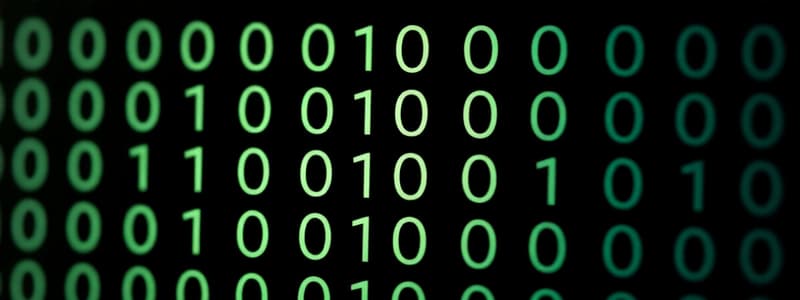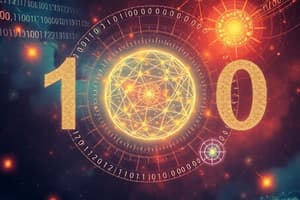Podcast
Questions and Answers
What is the decimal equivalent of the binary number 1111?
What is the decimal equivalent of the binary number 1111?
- 16
- 17
- 8
- 15 (correct)
What is the place value of the leftmost digit in the binary number 10000?
What is the place value of the leftmost digit in the binary number 10000?
- 32
- 8
- 2
- 16 (correct)
Which of the following binary numbers is equivalent to the decimal number 25?
Which of the following binary numbers is equivalent to the decimal number 25?
- 10101
- 11010
- 10110
- 11001 (correct)
What decimal value does the binary number 0.001 represent?
What decimal value does the binary number 0.001 represent?
If a binary number has the digits 1 at positions $2^0$, $2^2$, and $2^5$, what is its decimal equivalent?
If a binary number has the digits 1 at positions $2^0$, $2^2$, and $2^5$, what is its decimal equivalent?
A system uses a 4-bit binary number to represent unsigned integers. What is the maximum decimal number that can be represented?
A system uses a 4-bit binary number to represent unsigned integers. What is the maximum decimal number that can be represented?
Flashcards
What is the binary number system?
What is the binary number system?
Base-2 system where digits are 0 or 1.
How to convert binary to decimal?
How to convert binary to decimal?
Multiply each binary digit times 2 raised to its position.
Binary digit is 0, what to do?
Binary digit is 0, what to do?
Any digit times zero equals zero.
What is 2^0?
What is 2^0?
Signup and view all the flashcards
Binary '1' in the 2^4 position?
Binary '1' in the 2^4 position?
Signup and view all the flashcards
Decimal of Binary 11011
Decimal of Binary 11011
Signup and view all the flashcards
Fractional Binary Numbers
Fractional Binary Numbers
Signup and view all the flashcards
Fractional binary positions
Fractional binary positions
Signup and view all the flashcards
Study Notes
Converting Binary to Decimal Numbers
- Conversion from binary to decimal requires understanding that binary is base-2 and decimal is base-10.
- Binary digits are 0 or 1.
- Each binary digit is multiplied by 2 raised to the power of its position, starting from 0 on the right.
Conversion Process Explained
- Begin with the rightmost digit, which represents 2 to the power of 0.
- Moving left, the positions are 2 to the first power, 2 squared, 2 cubed, and so on.
- Digits with a value of 0 do not contribute to the decimal value.
- Focus on digits that are 1 and sum their calculated values. That is, 2 to the power of their position.
Example Conversions
- Binary number 1010 converts to decimal 10.
- (0 * 2^0) + (1 * 2^1) + (0 * 2^2) + (1 * 2^3) = 0 + 2 + 0 + 8 = 10
- Binary number 10010 converts to decimal 18.
- (0 * 2^0) + (1 * 2^1) + (0 * 2^2) + (0 * 2^3) + (1 * 2^4) = 0 + 2 + 0 + 0 + 16 = 18
Powers of 2
- 2^0 = 1
- 2^1 = 2
- 2^2 = 4
- 2^3 = 8
- 2^4 = 16
- 2^5 = 32
- 2^6 = 64
- 2^7 = 128
- 2^8 = 256
- Knowing these powers facilitates quicker conversions.
Additional Examples
- Binary number 11011 converts to decimal 27.
- (1 * 2^0) + (1 * 2^1) + (0 * 2^2) + (1 * 2^3) + (1 * 2^4) = 1 + 2 + 0 + 8 + 16 = 27
Practice Problems
- Convert the binary numbers 10110011 and 01010110 into decimal numbers.
Solutions to Practice Problems
- Binary 10110011 equals decimal 179.
- (1 * 2^0) + (1 * 2^1) + (0 * 2^2) + (0 * 2^3) + (1 * 2^4) + (1 * 2^5) + (0 * 2^6) + (1 * 2^7) = 1 + 2 + 0 + 0 + 16 + 32 + 0 + 128 = 179
- Binary 01010110 equals decimal 86.
- (0 * 2^0) + (1 * 2^1) + (1 * 2^2) + (0 * 2^3) + (1 * 2^4) + (0 * 2^5) + (1 * 2^6) + (0 * 2^7) = 0 + 2 + 4 + 0 + 16 + 0 + 64 + 0 = 86
Converting Fractional Binary Numbers
- For binary fractions, digits to the right of the decimal point represent negative powers of 2, starting with 2^-1.
- The pattern associates the first digit after the decimal with 2^-1, the second with 2^-2, and so on.
Example and Explanation
- The binary number 1100.101 is equivalent to 12.625 in decimal.
- Digits to the left of the decimal are 2^0, 2^1, 2^2, 2^3 from right to left.
- Digits to the right of the decimal are 2^-1, 2^-2, 2^-3 from left to right.
- (0 * 2^0) + (0 * 2^1) + (1 * 2^2) + (1 * 2^3) + (1 * 2^-1) + (0 * 2^-2) + (1 * 2^-3) = 0 + 0 + 4 + 8 + 0.5 + 0 + 0.125 = 12.625
Negative Powers of 2
- 2^-1 = 1/2 = 0.5
- 2^-2 = 1/4 = 0.25
- 2^-3 = 1/8 = 0.125
- 2^-4 = 1/16
- 2^-5 = 1/32
- 2 to the negative power is the reciprocal of 2 to the positive power. For example, 2^-n = 1 / 2^n
Practice with Fractional Binary Numbers
- Convert the binary number 10011.011 into a decimal number by assigning the appropriate values to each digit.
Solution
- The binary number 10011.011 equals 19.375 in decimal form.
- (1 * 2^0) + (1 * 2^1) + (0 * 2^2) + (0 * 2^3) + (1 * 2^4) + (0 * 2^- 1) + (1 * 2^-2) + (1 * 2^-3) = 1 + 2 + 0 + 0 + 16 + 0 + 0.25 + 0.125 = 19.375
Studying That Suits You
Use AI to generate personalized quizzes and flashcards to suit your learning preferences.
Description
Learn how to convert binary numbers to decimal numbers. Understand the base-2 system and the conversion process. Each binary digit is multiplied by 2 raised to the power of its position.




